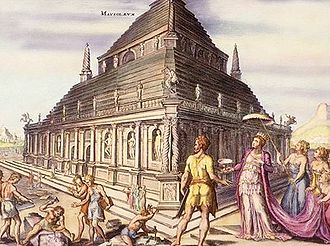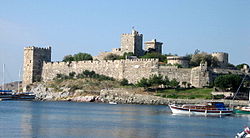Mausoleum at Halicarnassus

The Mausoleum at Halicarnassus, or Tomb of Mausolus,[1] was a tomb built between 353 and 350 BC at Halicarnassus (present Bodrum, Turkey). It was built for Mausolus, a satrap in the Persian Empire, and Artemisia II of Caria, who was both his wife and his sister.
The building was designed by the Greek architects Satyros and Pythius of Priene. It was about 45 meters (135 feet) tall. Each one of the four sides was decorated with sculptural reliefs created by one of four Greek sculptors — Bryaxis, Leochares, Scopas and Timotheus.[2] It was such an accomplishment that Antipater of Sidon said it was one of the Seven Wonders of the World. The word mausoleum has come to be used generically for any grand tomb.
Mausoleum At Halicarnassus Media
Mausolus (casting from the Pushkin Museum).
Colossal statues of a man and a woman from the Mausoleum at Halicarnassus, traditionally identified as Mausolos and Artemisia II, around 350 BC, British Museum.
A fragmentary horse from a colossal four-horse chariot group that topped the podium of the Mausoleum at Halicarnassus.
Relief of an Amazonomachy from the Mausoleum at Halicarnassus.
Coinage of Mausolus as Achaemenid dynast of Caria. Head of Apollo facing/ Zeus Labrandos standing, legend ΜΑΥΣΣΩΛΛΟ ("Maussollo"). c. 376–353 BC.
Related pages
Further reading
- Kristian Jeppesen, et al. The Maussolleion at Halikarnassos, 6 vols.
- Thiollet, Jean-Pierre; Roboth, Francois; Fehr, Francis (2010). Bodream ou reve de Bodrum. ISBN 978-2-35035-279-4.
References
- ↑ Greek: Μαυσωλείο της Αλικαρνασσού, modern Turkish: Halikarnas Mozolesi. "Mausoleion" meant "[building] dedicated to Mausolus".
- ↑ Smith, William (1870). "Dictionary of Greek and Roman Antiquities, page 744". Archived from the original on 2006-06-18. Retrieved 2006-09-21.
Other websites
- penelope.uchicago - The Tomb of Mausolus (W.R. Lethaby's reconstruction of the Mausoleum, 1908)









